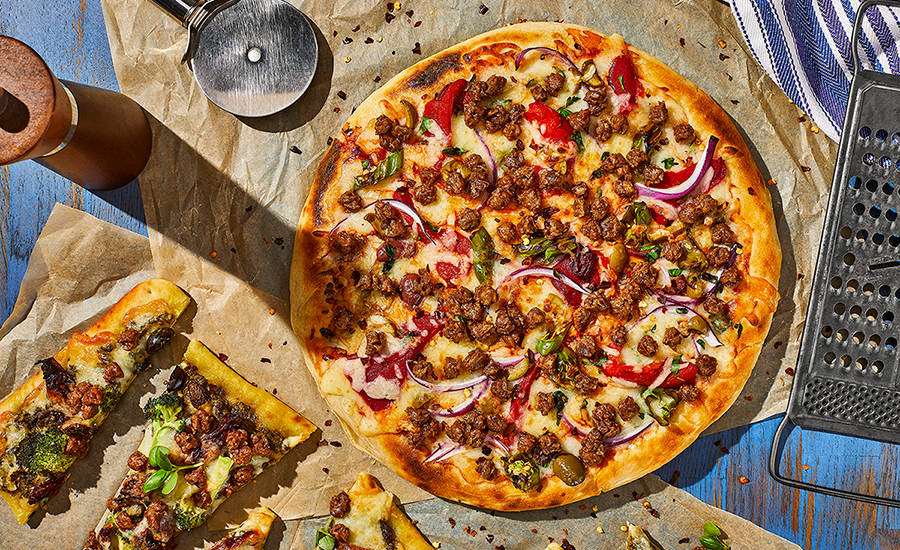Food formulators are ushering in a new phase in the evolution of plant-based protein alternatives. With plant-based, vegetarian and vegan food products meat becoming more common, formulators hope to create more complex applications and address health-conscious consumers’ demands for variety and good taste.
Examples range from faux chicken nuggets, to “crab” cakes, to meatballs. Developing these as commercial applications requires plant proteins that can hold up to processing while maintaining their fibrous structure and piece quality.
MGP Ingredients is a leader in the use of extrusion technology to create textured plant proteins that exhibit a meat-like, fibrous structure; resilient texture; good hydration properties; and finally, neutral flavor in a finished product. Its proven textured wheat protein has been part of many successful product launches during the past 20 years.
Now, it anchors the ProTerra ® line of textured plant proteins, which includes a new gluten- and allergen-free pea protein series. The wheat and pea proteins are made from non-GMO sources, contain no cholesterol, hormones or antibiotics, and come in a variety of sizes and shapes to provide options for a number of food formulations.
After low-moisture extrusion of wheat gluten and pea protein isolate in a twin-screw extruder, the resulting textured wheat proteins and textured pea proteins exhibit meat-like appearance with fibrous structure and—after hydration—resemble chicken, pork or beef meat. Formulation and processing parameters can be changed to make food products with delicate texture and fine fibers for plant-based fish or crab cakes, or a chewier bite for plant-based chicken, pork, or beef.
Both products are available in several forms differing in size, shape, color, and hydration properties. Shapes can vary from crumbles (granules) to chips (flakes) or shreds of assorted sizes. Textured wheat protein contains 8.4-9.6% moisture, 58.9-64.6% protein, and 4.4-5.4% % fat whereas textured pea protein contains 2.7-7.1% moisture, 75.4-79.0% protein, and 6.8-7.7% fat.
Better Blends
MGP food scientists found that a blend of ProTerra wheat and pea products is an ideal choice for creating complicated applications. While each protein has key benefits on its own, there is significant benefit to using them in a mixture.

After low-moisture extrusion of wheat gluten and pea protein isolate in a twin-screw extruder, the resulting textured wheat proteins and textured pea proteins exhibit meat-like appearance with fibrous structure and—after hydration—resemble chicken, pork or beef meat. Photo courtesy of MGP Ingredients
There is a synergy when pea protein and wheat protein are combined. Pea protein is low in methionine (0.8%) and cysteine (0.8%) but high in lysine (6.3%), whereas wheat protein is high in methionine (1.3%) and cysteine (2.2%) but low in lysine (1.4%). Methionine is the first limiting amino acid in pea protein while lysine is the first limiting amino acid in wheat protein. (A limiting amino acid is defined as the amino acid that is present in the least amount relative to human nutritional requirements.)
The resulting blend of the pea and wheat proteins yields a balanced amino acid composition resulting in improvement of the nutritional value as indexed by PDCAAS. In addition, a blend of ProTerra textured wheat and pea proteins resulted in improved piece differentiation and improved texture, both key factors in creating successful food products.
"MGP food scientists found that a blend of ProTerra wheat and pea products is an ideal choice for creating complicated applications. While each protein has key benefits on its own, there is significant benefit to using them in a mixture."
For piece differentiation that positively impacts texture, a combination of ProTerra textured wheat protein in shredded format (ProTerra 1200) and ProTerra textured pea protein in chips format (ProTerra 2350) performed well in plant-based “chicken” nuggets and patties, as well as in plant-based “crab” cakes. The other major benefit was the enhanced nutritional profile of the food product, where protein quality was enhanced due to the complementary effect on amino acid composition by using the blend.
In other types of applications, the granule version of ProTerra textured wheat protein (ProTerra 1100) can be used as a protein-dense inclusion or toppings on cookies. ProTerra 1200 or 2200 (shredded format) also can be used to extend coconut shreds in pie applications.
Food formulators are working to meet demand for plant-based food products that successfully mimic meat, seafood and poultry products in terms of taste, texture and appearance, while addressing consumers’ desire for healthier options. ProTerra textured proteins—on their own or in a wheat-pea blend—are the right ingredient to achieve those goals.

